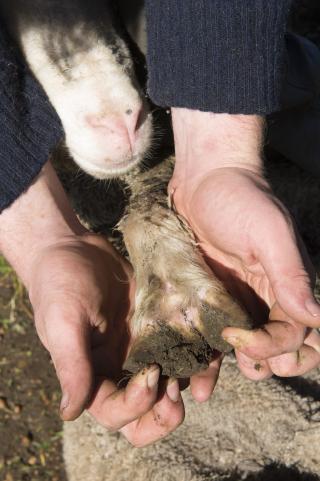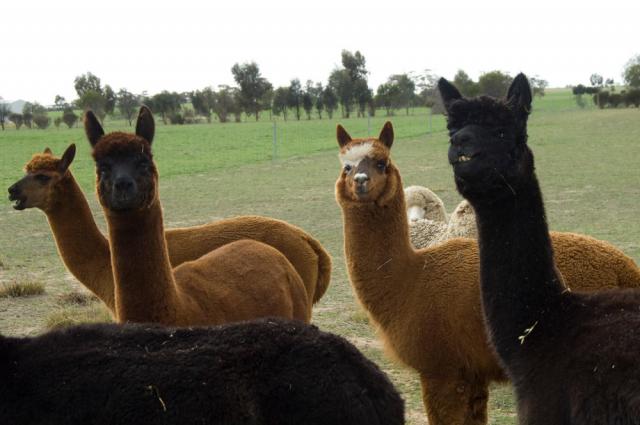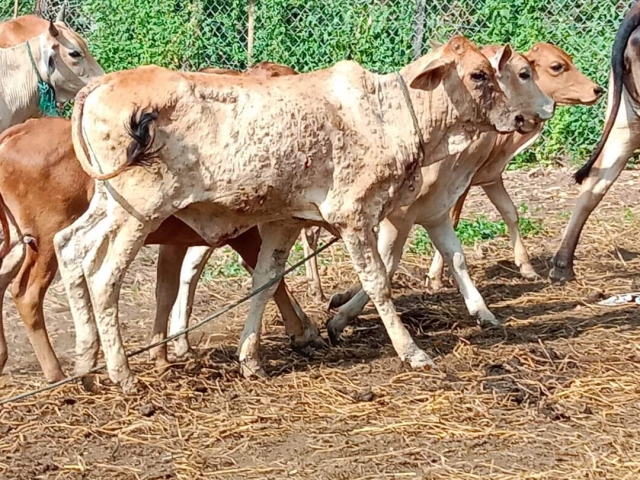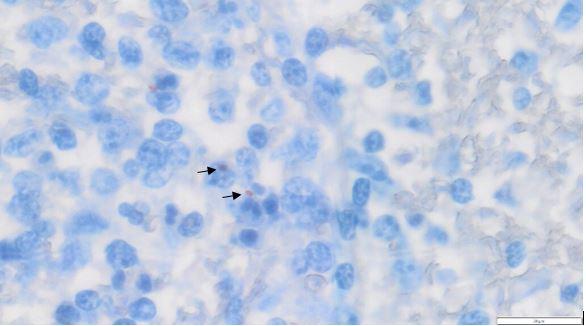Recent livestock disease investigations
Case 1: Melioidosis diagnosed in alpacas in the Perth metropolitan region
- Two cases of melioidosis have been confirmed in alpacas within the Perth metropolitan region.
- One case involved two deaths, following clinical signs of reduced body condition and laboured breathing, and multiple were affected with mild respiratory signs. The clinical signs did not resolve with antibiotic treatment. The owner contacted a DPIRD field veterinarian, and a post-mortem was performed at DPIRD’s Diagnostic Laboratory Services (DDLS) in South Perth.
- Another case of melioidosis was diagnosed at a similar time also within the Perth metropolitan region.
- Melioidosis was confirmed by laboratory testing.
- Melioidosis results from infection by the bacterium Burkholderia pseudomallei, which is endemic in the tropical northern parts of Australia. It occurs rarely in the south and has been diagnosed previously in the Gidgegannup, Chittering and Toodyay areas. The bacterium is found in soil and can survive for prolonged periods where there is optimal moisture, temperature and pH. During heavy rainfall or soil disturbances such as earthworks, the bacterium can move onto the soil surface where it can infect people and animals. Camelids and goats are most susceptible to disease.
- Camelids may develop respiratory disease with coughing, nasal discharge and difficulty breathing. Other clinical signs may include hindleg weakness, incoordination, wasting and sudden death. For clinical signs in other animals including sheep, pigs, cattle, horses, see the DPIRD melioidosis webpage.
- Melioidosis is a zoonotic disease. Most infections in people occur through exposure to soil and water containing the bacterium. People who are concerned about their risk of melioidosis should consult their general medical practitioner or contact their local public health unit.
If you see signs of disease in animals that could be melioidosis, please contact Dr Anna Erickson, DPIRD Senior Field Veterinary Officer for assistance: 08 9881 0211, mobile 0437 801 416, email: anna.erickson@dpird.wa.gov.au.
Any questions relating to public health, including if you think staff or clients may have been exposed to a potential source of infection, should be referred to WA Health’s Metropolitan Communicable Disease Control service on 08 9222 8588 or 1300 MCDCWA (1300 623 292).
Case 2: Lumpy skin disease (LSD) excluded at abattoir
- Three animals with skin lesions were inspected at ante-mortem by the on-plant veterinarian in a Kimberley region abattoir. Each animal displayed 6 to 7 lumps on skin of the neck. There were no other clinical signs.
- The locations of the nodules were consistent with an injection site reaction.
- Samples of the lesions were sent to DDLS and ACDP laboratories and returned negative results for Lumpy skin disease (LSD).
- It is important to be vigilant and exclude LSD from any cattle with clinical signs consistent with LSD. Clinical signs in cattle include eye and nasal discharge, decreased milk production in lactating cattle, loss of appetite, and fever lasting 6 to 72 hours. Within 48 hours of onset of fever, skin nodules of 2 to 5 cm diameter will erupt, particularly on the head, neck, limbs, udder, genitalia and perineum. Cattle may lose body condition rapidly.
- Transmission of the virus is through biting insects, such as flies, mosquitoes, midges and ticks. It can be spread by the movement of infected animals or contaminated products and equipment. The virus is highly contagious affecting cattle and water buffalo. The virus cannot be spread to humans or to other species, such as sheep or goats.
- To prove WA is free of significant diseases, including disease that affect trade and to boost early detection of such diseases, the Significant Disease Investigation program supports private veterinarians through cost subsidy for an initial field and laboratory investigation of significant disease incidents in livestock. Contact your private veterinarian or your local DPIRD veterinarian for more information.
- Lumpy skin disease is a reportable disease in Australia. Eradication of LSD is difficult and early detection is essential for successful control and eradication. If you suspect a disease with these signs, contact your private veterinarian, local DPIRD veterinarian or the Emergency Animal Disease Hotline on 1800 675 888.
More information can be found on DPIRD's LSD webpage or on the Animal Health Australia LSD information and producer biosecurity plans webpage.
Case 3: Neurological signs in an ewe, confirmed as Listeriosis
- A producer in the south-west contacted a DPIRD field veterinary officer after seeing neurological signs followed by death in 2 sheep. A third sheep developed clinical signs. These sheep were of mixed ages and were in confined areas on silage and hay. Treatment was trialled in the previous two animals including subcutaneous magnesium and calcium solution, oral glucose, antibiotics and a non-steroidal anti-inflammatory. No response to treatment was noted in either animal.
- On clinical examination the sheep was unable to rise, paddling the legs, constant chewing motions, neck bent around towards the flank, incoordination when standing and full body tremors.
- There were no notable lesions on post-mortem. As this sheep fitted the transmissible spongiform encephalopathy (TSE) surveillance program eligibility criteria, samples were collected to rule out scrapie, an exotic disease that would affect access to international markets. The producer was able to claim a rebate of $110 (GST inclusive) under the TSE surveillance program.
- Laboratory testing at DPIRD Diagnostics and Laboratory Services (DDLS) identified Listeria sp. bacteria from the brain swab in combination with distinctive lesions in the spinal cord and brain under microscopic examination.
- TSE testing returned a negative result, assisting in proving Australia’s ‘free of BSE and scrapie’ classification to maintain access to international markets. Testing for lead toxicosis was also negative.
Investigations of neurological disease in sheep and cattle may be eligible for subsidies under the National Transmissible Spongiform Encephalopathy (TSE) surveillance program. For questions and further information on the TSE program, talk to your private veterinarian or your local DPIRD Field Veterinary Officer.
In spring, be on the lookout for:
Worms in sheep and cattle
- Signs of Barber’s pole worms include bottle jaw, fluid-filled abdomen, anaemia and sudden deaths. Other worm species may cause lost productivity, ill-thrift, weakness and diarrhoea.
- Young sheep and cattle require good worm control to achieve their potential growth rate.
- High stocking rates favour the spread of worms. Lambs will require an effective drench at weaning and should be put onto a paddock with a low worm burden.
- Worm egg counts are a useful tool to measure drench effectiveness. See the sheep Drench Decision Guide on the Wormboss website or read more on the DPIRD drench resistance webpage.
Read more on sheep worm control.
Read more on beef cattle worm control.
Polioencephalomalacia (PEM) in sheep and cattle
- Thiamine (vitamin B1) deficiency is the most common cause of PEM in WA.
- PEM most often occurs in WA when there is a sudden change to feed composition. All ages and classes can be affected.
- Most outbreaks involve only a few animals in the mob, but death rates can be as high as 10%.
- Signs include muscle twitching, seizures, head pressing, blindness, paddling and head thrown back, death.
- Animals treated in the early stages with thiamine may recover.
- Eligible disease investigations can be subsidised by the Significant Disease Investigation program – contact your DPIRD field veterinarian for information.
Read more on DPIRD’s PEM webpage.
Listeriosis
- Caused by the bacteria Listeria monocytogenes.
- Sources of infection include spoiled silage, rotten vegetables, contaminated soil, spoiled feed and where apparently healthy animals (including rodents) have shed the bacteria in their faeces.
- Livestock that consume contaminated feed material can be infected when rough feed causes abrasions in the mouth.
- Key signs: neurological signs (such as circling), unwillingness to rise and deaths. May also cause abortions 5 to 6 weeks before lambing, stillbirths or newborn lamb deaths.
- If feeding silage, ensure it has been properly prepared and any leftover feed is cleared away promptly to prevent spoilage.
- Listeriosis is zoonotic (can infect people). Producers should take precautions when handling sick stock. Pregnant and immune-compromised people should avoid contact with potentially infected animals and aborted materials.
If you see nervous/neurological signs in your livestock, phone a veterinarian. Some exotic diseases, such as transmissible spongiform encephalopathy, can cause similar signs. Testing helps to prove that WA is free from such diseases and further supports the industry.
Be on the lookout for virulent footrot
During late spring, be on the lookout for virulent footrot in sheep and goats. With spring, temperatures increase, and the moisture persists in our pastures. Footrot lesions, caused by bacterium Dichelobacter nodosus, become more apparent.
Virulent footrot first appears as moisture, reddening and hair loss between the toes. Varying degrees of lameness may occur, and more than one foot may be affected.
Things you can do to reduce the risk of virulent footrot entering your farm:
- Ask for a National Sheep Health Statement when buying sheep.
- Make sure your import inspections are completed on time.
- Keep your new sheep separate until you have two clear footrot inspections. Use separate yards and equipment for new sheep.
- Observe new sheep feet and check for lameness before mixing with your flock.
- If in doubt, call your local DPIRD Biosecurity Officer, and arrange a visit to inspect your sheep.
- The sooner the disease is detected and control the lower the economic impact on your flock and the industry.
Virulent footrot is a reportable disease in WA. If you think an animal/flock has signs of footrot, you must contact your local DPIRD biosecurity officer or private vet to take samples for laboratory testing.
See the DPIRD webpages for information on benign and virulent footrot in WA.

Livestock disease investigations protect our markets
Australia’s ability to sell livestock and livestock products depends our disease surveillance systems to demonstrate WA is free from some major livestock diseases that are reportable allowing producers to trade into a range of high value markets.
Find out more about WA's animal health surveillance programs.
Feedback
We welcome feedback. To provide comments or to subscribe to the veterinary edition of the monthly newsletter, WA Livestock Disease Outlook, email: waldo@dpird.wa.gov.au. To see previous issues of the WALDO – for producers, please visit our archive webpage.



